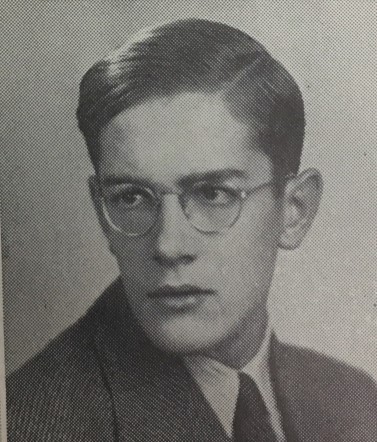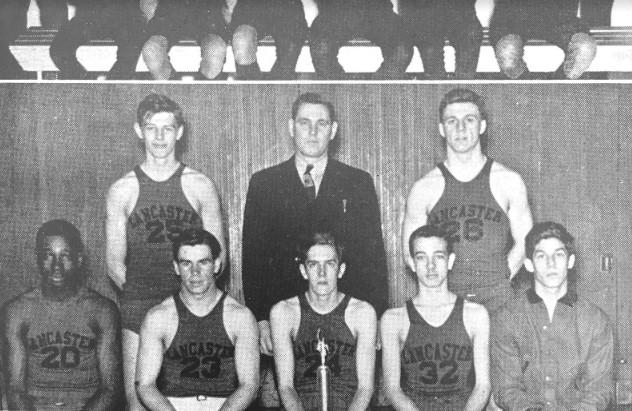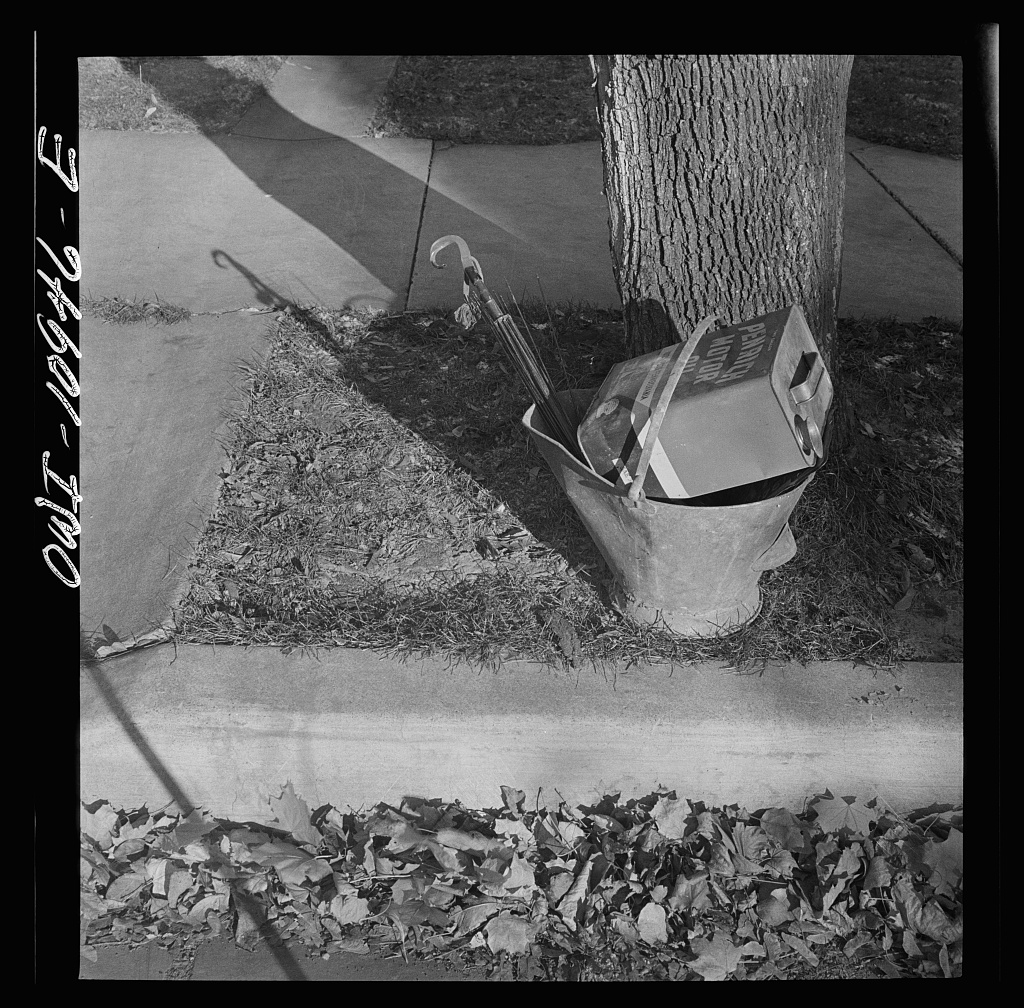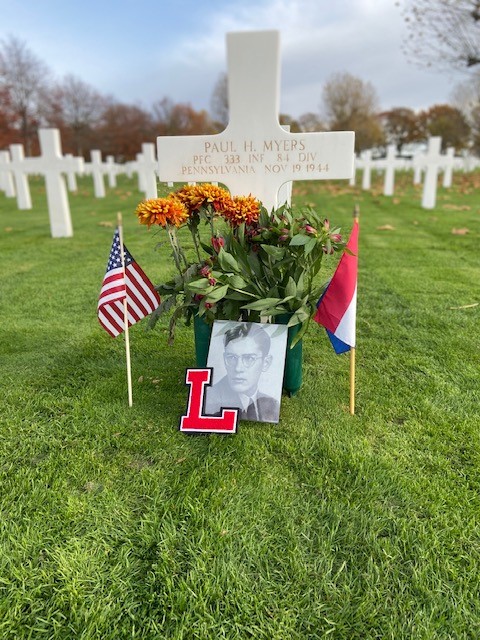Private First Class Paul Henry Myers

- Unit: 333rd Infantry Regiment, 84th Infantry Division
- Service Number: 33500509
- Date of Birth: February 11, 1923
- Entered the Military: February 11, 1943
- Date of Death: November 19, 1944
- Hometown: Lancaster, Pennsylvania
- Place of Death: near Geilenkirchen, Germany
- Award(s): Purple Heart
- Cemetery: Plot G, Row 16, Grave 3. Netherlands American Cemetery, Margraten, Netherlands
Mentored by Ms. Alison Browning
J.P. McCaskey High School Campus
2019-2020
Early Life
Paul Henry Myers was born on February 11, 1923 in Lancaster, Pennsylvania to Lloyd Van Emery Myers and Mabel Elizabeth Rutter. He had four siblings: Harold, Harry, Ruth and Lloyd, Jr. The family lived in the heart of downtown Lancaster at 118 Dauphin Street. His family co-owned a furniture store on King Street. Myers’ father, Lloyd, worked as the upholsterer at the store while his brother, Harold, did the interior designing. Myers’ brother, Sergeant First Class Harry Myers, a sales clerk at the store, also served in the U.S. Navy in the South Pacific during World War II.
Myers attended John Piersol McCaskey High School, where he studied classes in the commercial track. Myers wanted to be a bookkeeper after graduating from high school. While at McCaskey, Myers played varsity basketball and volleyball. Following his graduation from high school in 1941, Myers attended the Engineering College in Easton, Pennsylvania for six months. During his time there, he met Helen Louise Keller, a soprano soloist at the First Methodist Church. On July 13, 1944, Lancaster New Era included their engagement announcement. After working for a brief period of time at the Armstrong Cork Factory, Myers enlisted in the U.S. Army on his twentieth birthday, February 11, 1943.

Homefront
Wartime production turned the state of Pennsylvania into a major powerhouse as production demands increased. Pennsylvania led the nation in coal and steel production, both vital for energy and the construction of wartime materials. In Lancaster, Armstrong Industries, more specifically, Armstrong Cork Company, helped in the production of projectiles and other war related materials.
Lancaster and the surrounding communities supported the war effort by buying war bonds, planting victory gardens and participating in scrap drives. Every week Lancasterians placed their metal scraps outside for collection. These scraps were then repurposed into helmets, ammunition and new parts for ships and planes.

Military Experience
Paul Henry Myers enlisted in the U.S. Army on February 11, 1943. Myers first trained at North Camp Hood and at Camp Maxey in Texas, and eventually he was stationed at Camp Claiborne in Rapides Parish, Louisiana. During this time, local newspapers reported that Myers visited his family twice before heading to the European front.
The Railsplitters Division
Myers served in the 333rd Infantry Regiment of the 84th Infantry Division, known as the Railsplitters Division. In the spring of 1943, the 84th Infantry Division began large-scale war games in Louisiana. During this time the division combined the operations of the infantry, artillery and other branches to sharpen their combat efficiency.
In spring 1944, the 84th Infantry Division, including the 33rd, 334th and 335th Infantry Regiments, completed small unit training to test their efficiency at Camp Claiborne, Louisiana. By the summer, training for the division intensified. Each member of the 84th was trained for both amphibious and air transport operations.
In late August 1944, the 84th Infantry Division received its orders for overseas movements. The entire division moved to Camp Kilmer, New Jersey, and from there sailed to various ports in England. The 84th Infantry Division stayed in England for three weeks before heading to France. The division assembled in Normandy, France on November 4, 1944, a few months after D-Day. From there his infantry moved through Belgium and the Netherlands.
Operation Clipper
The 333rd Infantry Regiment took part in Operation Clipper, a preliminary mission to the wider Allied Operation Queen whose overall objective hinged on gaining control of the Roer Valley and the Hurtgen Forest. Specifically, Operation Clipper worked to drive the enemy out of the Geilenkirchen salient, an area in western Germany in the North Rhine-Westphalia region. The Operation began on November 18, 1944.
The next day, Myers and the 333rd Infantry Regiment worked to clear the valley southwest of Geilenkrichen and seize hold of the town. Reports stated heavy enemy defenses in the small area surrounding the town, leading many to expect fierce opposition to the assault. General Alexander R. Bolling said that this advance down the valley was “a most difficult operation for new troops because the entire valley was covered by the Siegfried defenses.”
Death
During the early part of Operation Clipper, Private First Class Myers sustained battle wounds and died on November 19, 1944. His family received word via telegram that Myers had been reported missing in action (MIA). Sadly, a few days later, his family received a second telegram, in which they learned he died in combat. The Myers family chose to have his remains interred at Netherlands American Cemetery in Margraten. However, they honored their son and his sacrifice with a memorial stone that is located at the Woodward Hills Cemetery in Lancaster, Pennsylvania.
Eulogy
Private First Class Paul Henry Myers was born in Lancaster, Pennsylvania in 1923. Myers had a large family who lived in the heart of downtown. Myers graduated from J.P. McCaskey High School, where he was a two-sport athlete who earned varsity letters in volleyball and basketball. Myers enlisted in the U.S. Army on his twentieth birthday.
Myers served in the 33rd Infantry Regiment of the 84th Infantry Division. Private First Class Myers and the 333rd Infantry Regiment moved through France, Belgium, the Netherlands, and Germany. The 333rd Infantry took part in Operation Clipper, and it was during this operation that Private First Class Myers was killed. The Myers family chose to bury their son at Netherlands American Cemetery in Margraten, but they also erected a memorial stone in his honor in his hometown of Lancaster, Pennsylvania.
Paul, since sports is something that you and I have in common, I brought you a McCaskey Varsity Letter to illustrate the bond we share as proud Lancastarians and McCaskey Proud Red Tornadoes. Being able to walk in the same halls as you once did, and being able to learn in some of the same classrooms as you, help me put into perspective just how brave you were to enlist in the Army. You served your country on the front lines, making the ultimate sacrifice to fight for the nation, friends, and family you loved so much. I cannot express my gratitude enough. I found a poem, written by Christian Martin of the McCaskey Class of 1943 that can express better than I, my profound awe of your sacrifice:
“That We Take Increased Devotion”
Out of death and the ocean,
Out of the earth and the sky
Gather their flames of devotion
And never let them die.
Think of the hearts they have given,
Think of the youth they have lost,
Sigh for their fond dreams riven,
And never forget the cost.
They have not asked for pity;
They sought not after gold;
They died that so what is holy
Be not to evil sold.
They gather their flames of their glory
And fix them as stars above
To guide the wings of freedom
On their missions of rescue and love.

Reflection
Prior to this opportunity with Operation Liberty, I never acknowledged or reflected upon the freedoms that I experience every day. However, this trip allowed me to put into focus the sheer cost that millions of men and women have had to pay just so I could live my current day-to-day life. This eye-opening experience highlighted those values that I often took for granted. Now I can help others see how much we as a society truly take for granted and how much we owe to the brave men and women who sacrificed their lives.
The entire trip itself was fascinating; however, nothing quite took my breath away more than the actual experience at the Netherlands American Cemetery. That entire afternoon from start to finish was nothing short of surreal. I was able to connect with Dutch citizens over our appreciation of the same soldier and discuss with them Private First Class Myers’ life and sacrifice. Then I was able to honor Private First Class Paul Myers through my eulogy. The whole experience made me feel like I was a part of this esoteric community of those who have a common understanding and appreciation of these men and women, which is rarely seen today.
Being able to research any one soldier would have been a fascinating look into a side of World War II not often addressed. However, being able to research a soldier who lived in the same town and attended the same high school as I did has exponentially deepened my appreciation of this brave man. I now see it as a personal objective to ensure that the sacrifices made by Private First Class Myers, as well as all of the other soldiers, do not simply disappear into the void of history’s unknown. They are silent heroes; however, it is now our job to now act as the voice that they deserve. Having the ability to tell their story allows me to express my gratitude in a most profound and inspirational way.
Bibliography
Primary Sources
“Announce Engagement of Pvt. Paul H. Myers.” Lancaster New Era, July 13 1944. Newspapers.com (560179986).
John Piersol McCaskey High School. Vidette. Lancaster, PA, 1941.
John Piersol McCaskey High School. Vidette. Lancaster, PA, 1943.
Pennsylvania. Lancaster County. 1930 U.S. Federal Census. Digital Images. ancestry.com.
Pennsylvania. Lancaster County. 1940 U.S. Federal Census. Digital Images. ancestry.com.
“Pfc. Myers Missing in Germany Since Nov. 19.” Lancaster New Era, December 6, 1944. Newspapers.com (56081929).
“Pfc. Myers Killed in Germany On Nov. 19.” Lancaster New Era, December 7, 1944. Newspapers.com (560819413).
Records for Paul Henry Myers; World War II Army Enlistment Records, 1938-1946 [Electronic File], Record Group 64; National Archives at College Park, College Park, MD [retrieved from the Access to Archival Databases at aad.archives.gov/.
Secondary Sources
“Arsenal of America: Pennsylvania during World War II,” Explorepahistory.com. Accessed October 9, 2019. explorepahistory.com/story.php?storyId=1-9-19&chapter=3.
Brubaker, Jack. “Lancaster manufactured WWII naval shell returns to Armstrong archive.” Lancaster Online, October 26, 2017. lancasteronline.com/news/local/the-scribbler-lancaster-manufactured-wwii-naval-shell-returns-to-armstrong/article_d1cf0f1a-b8fc-11e7-8121-bbeabc3beb95.html.
Draper, Theodore. The 84th Infantry Division in the Battle of Germany. Mount Pleasant: Arcadia Press, 2019.
“Paul H. Myers,” Find a Grave. Accessed October 9, 2019. www.findagrave.com/memorial/71962342.
“Paul H. Myers.” American Battle Monuments Commission. Accessed October 15, 2019. www.abmc.gov/node/387449.
“The 84th Infantry Division,” The Holocaust Enclycopedia. Accessed October 9, 2019. encyclopedia.ushmm.org/content/en/article/the-84th-infantry-division.
“The 84th Infantry Division,” U.S. Army Center of Military History. Accessed October 9, 2019. history.army.mil/documents/ETO-OB/84ID-ETO.htm.
“World War II and the Pennsylvania Homefront,” PA Digital. Accessed October 9, 2019. padigital.org/world-war-ii-and-the-pennsylvania-homefront/.

